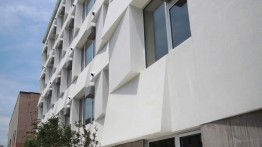Chris Benedict AR’86

Chris Benedict AR’86
In an article in Architectural Digest, Chris Benedict relayed a story about the first Earth Day in 1970 when as a child she volunteered to collect trash in her Connecticut town, which the grownups proceeded to dump in the woods. “I thought, ‘Aren’t there any adults in charge of this?’ So when I was able to start my own firm, I thought, ‘I'm an adult; I can be in charge of this.’"
That thought eventually led to her long career deploying sustainable building practices, and even leading the field by formulating just what those environmentally-conscious practices should entail. She is a champion of passive housing, a way of designing that allows a building to use the energy within it—whether generated by the residents or solar heat. This is accomplished by erecting a building shell of insulated exterior walls, roof, and floor slabs in addition to a ventilation system that brings in fresh air and reuses heat from exhaust air—an approach that keeps houses warm in winter and cool during summer months.
In 2014, for instance, Benedict designed Knickerbocker Commons in Bushwick, Brooklyn, the country's first mid-sized apartment building to conform to passive house design standards. Developed by the New York City housing agency’s Low Income Rental Program. Knickerbocker Commons has a sculpted façade made of state-of-the-art layered insulation systems that shade windows in summer and maximize exposure in winter. Each of the building’s 24 apartments have their own ventilation systems, air-tight window air conditioning, and small radiators. These strategies have resulted in 85 percent less energy use to heat than is typically required for a New York City apartment building in the winter. Low-voltage equipment and water reuse decreases energy costs to 20% of that of an average NYC building its size. Twenty-three of the apartments were rented to people earning from 30 to 60 percent of the Area Median Income (AMI) with one unit set aside for the building’s superintendent.
At a 2019 talk given at that year’s Passive House Institute US conference, she recalled how passive housing was a field with few practitioners and not part of any curriculum: “25 years ago, I thought, what the heck is a heat load calculation? I had to teach myself and create my own spread sheets. It became one of the more revealing experiences of my career.”
She began to realize that the city’s energy code hindered some of the most innovative strategies available for best heating conservation practices, specifically to allow for exterior insulation when renovating a building. “My requests were rejected for several years until Mayor Bloomberg created a task force for greening the code, and I was able to add two measures,” she said at the 2019 talk. “I think insulation is activism.”
She has married those technical innovations to the aesthetics of great form: “ I find poetry in the technical,” she recently said. “And that I strive to create iconic work that speaks to the nature of sustainable buildings.”




